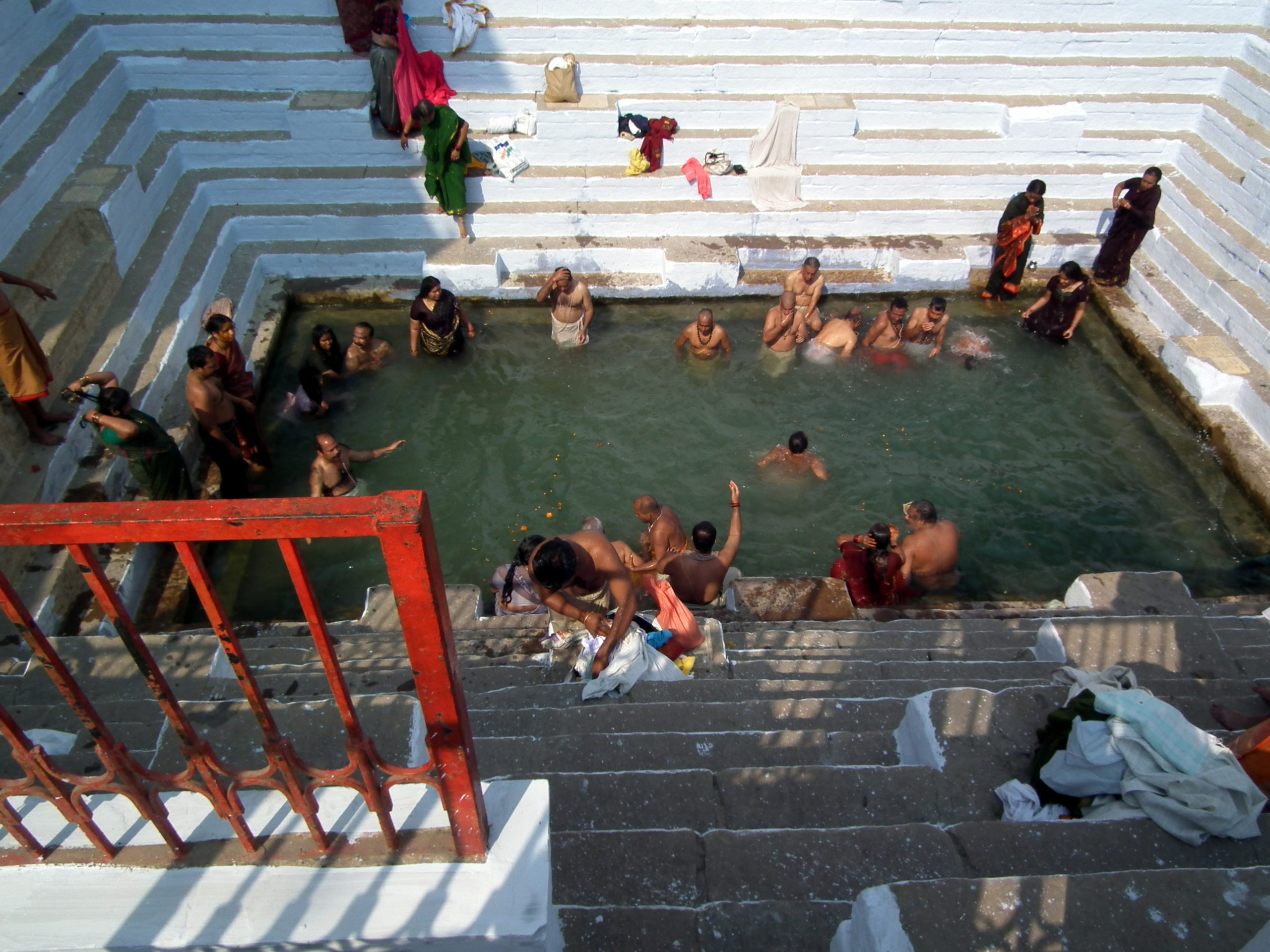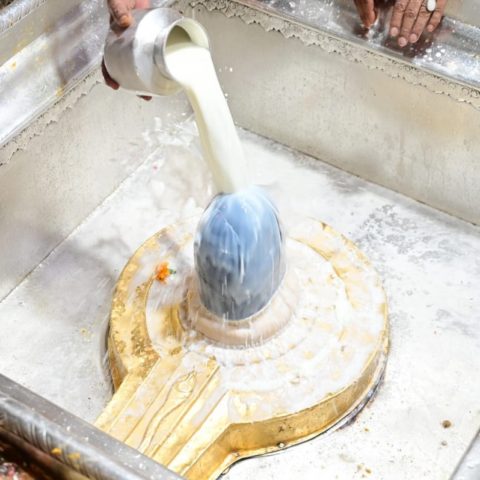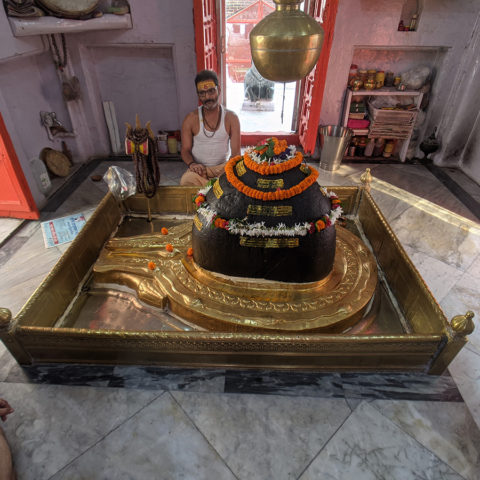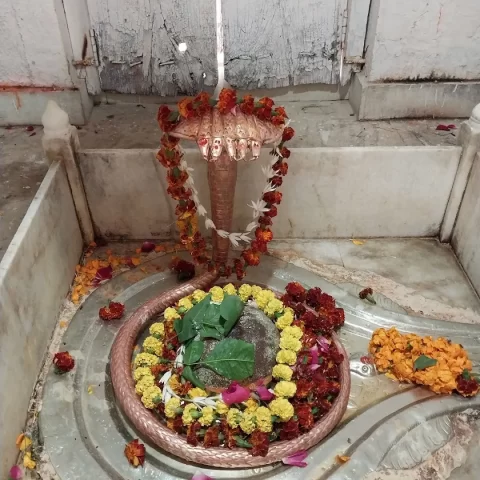
Manikarnika Ghat is the most important tirtha of Kashi. In fact the purpose of Kashi Yatra is not achieved if an aspirant devotee does not take a holy dip in this tirtha. It is one of the 84 Ghats of Kashi which lies on the banks of the sacred River Ganga. Three ghats are very popular in Kashi i.e., Harishchandra Ghat, Dashashwamedha Ghat and Manikarnika Ghat. Manikarnika Ghat is a popular holy cremation spot in Kashi.
The Manikarnika ghat came into being and became popular due to the sacredness of the Manikarnika Kund which was blessed by Lord Vishnu as well as Lord Shiva along with Parvathi Devi. In the Skanda Purana, Lord Shiva says that one who worships him as Kashi Vishwanath after taking a dip in the Manikarnika Kund pleases him immensly.
The ghat is lit up almost all the time with burning dead bodies. Many devotees come to Kashi, especially in old age desiring to die in Kashi and get cremated at Manikarnika Ghat. Dead bodies are brought here and dipped in the sacred Ganga and then cremated. Here, wood used for cremation is carefully selected and weighed as needed.
At Manikarnika Ghat, cremation of the dead is done like a festival. The belief is that there is no more birth or death after being cremated here in Kashi. In fact, Kashi got the name Maha Smashana (the great cremation ground) from the very nature of Manikarnika Ghat.
The ghat’s popularity apart from being a holy cremation ground can be seen from historical art works such as paintings, etc.
How was Manikarnika Ghat created?
The Kashi Khanda of Skanda Purana details the creation of the Manikarnika Kund in a conversation between Agastya Muni and Skanda. The creation and glories of Manikarnika Kund were first spoken by Lord Shiva to Parvathi Devi when she asked them. The ghat came up around the Kund.
Manikarnika Ghat was created by Lord Shiva in the company of Parvathi Devi. Once, Lord Vishnu was determined to perform penances in Kashi. He dug a pond with His celebrated Sudarshana Chakra and filled it with drops of sweat coming from his Lotus limbs. The pond came to be known as Chakrapushkarini as it was dug by Lord Vishnu’s Sudarshana Chakra.
Thereafter, Lord Vishnu took a resolve to perform penances for 50,000 years by the Chakrapushkarini. The strength of the Lord’s resolve astonished Lord Shiva who praised Lord Vishnu. After Lord Vishnu was praised, Lord Shiva said the following:
“On seeing the steady increase of this penance of yours, I shook my head having serpents. As a result of that movement, my gem-set earring fell down. It was set with jewels and was beautiful in appearance. Let this (sacred expanse of water) be named Manikarnika. This splendid sacred place had become a well known as Chakrapushkarini Tirtha formerly, because it was dug out by means of your discus, O Lord holding the conch, discus and mace. Let it become famous by the name Manikarnika here in this world, ever since the time when the gem-set earring fell into it from my ear.”
In reply Lord Vishnu said “O Lord, O beloved of the daughter of the Mountain, by virtue of the dropping of your pearl earring here, let this holy spot become the greatest of all holy spots that are salvation- granting holy places.”
The Glories of Manikarnika Ghat
Lord Vishnu requested that Lord Shiva bless those devotees who perform devotional acts at Manikarnika Kund or even simply visit it. Lord Vishnu asked for the following:
“O Shambhu, in this sacred Tīrtha of the gem-set earring, those who perform the following religious rites are to be benefited by the same performance. The rites are: Sandhya prayers, holy bath, Japa, Homa, the excellent study of the Vedas, Tarpana, offerings of balls of rice, the worship of the Deities, many Saptatantu sacrifices, the gifts of cows, plots of land, gingelly seeds, gold, horse, light, cooked rice, garments and ornaments, giving a virgin in marriage, Vratotsarga rite, Vrishotsarga (letting off a bull-calf) rite, installation of Lingas, etc.
The devotee realizes that life is transient. (Being) highly intelligent, he is conscious that dangers are extensive and riches are momentary. Let those who perform all these rites attain everlasting liberation as the fruit of those holy rites. Let those other rites too, performed excellently and with faith, be the bestower of salvation.
Barring Prayopavesha (fasting unto death), no one shall indulge in self-killing. O Ishana, let those rites be the cause of ultimate salvation. After performing a noble rite even on some other occasions, the devotee should neither boast about nor regret it. O Isha, with your blessings let all those holy rites bear everlasting fruits here. O Isha, with your grace let everything concerning him be of never-ending benefit. O Sadashiva, let this holy place be more splendid in its outcome than whatever exists, had existed and will exist later.”
“By resorting to Manikarnika here for only five nights, let there be that benefit which is said to be the result of resorting to all the (other) holy places granting liberation.”
After agreeing to the proposal put forth by Lord Vishnu in full, Lord Shiva also declares the following benefits of taking a holy bath in the Manikarnika Ghat.
- “By taking a good ablution in Manikarnika alone, one gets that merit which is usually obtained through elaborate bathing in all the sacred waters.”
- “One who takes the holy ablution with perfect faith in Manikarnika shall obtain the benefit that accrues from all the other holy places and all the merits through all types of gifts.”
- “Even if one undertakes the holy ablution in accordance with the injunctions but without faith, he too shall get the merit that enables him to attain heaven.”
- “By taking the holy bath with due faith and in accordance with the injunctions and by performing the Tarpana-rites for the Devas and others by means of gingelly seeds, Darbha grass and barley grains perfectly, one shall obtain the benefit of all the Yajnas.”
- “A man with faith, who takes the holy bath in accordance with the injunctions and performs all rites of libation shall obtain the benefit of all the Mantras through the Japa and adoration of the Deities.”
- “By taking the holy bath with due observance of the vow of silence, and through the visit of Vishvesha, a man who controls all his sense-organs and restrains his speech, shall obtain the welfare brought about by all the holy vows.”
How to reach Manikarnika Ghat
Devotees come to Manikarnika Ghat to bathe in the sacred Manikarnika Kund. While there are people who come to witness the burning of the dead at the ghat from a building nearby. Photography is strictly prohibited here. For a holy dip in the Manikarnika Kund while visiting Kashi, the Kashi Yatra and Ayodhya-Kashi Yatra services from Tirtha Yatra would be an ideal choice to consider.
To reach Kashi first, you may choose any of the below methods:
By Road: Kashi is well connected by road to major cities in India such as New Delhi, Mumbai, Lucknow, etc. You can travel in a private vehicle from other cities or hire a taxi. Luxury buses and normal buses are available from Lucknow frequently.
By Rail: Kashi is very well connected to major cities and towns in India via the five railway stations i.e., Kashi Railway Station, Varanasi Junction (also called Varanasi Cantt), Varanasi City, Banaras Railway Station and Pt. Deen Dayal Upadhyaya Junction. Tickets can be reserved up-to any one of these five stations.
By Air: Kashi is accessible by air through the Lal Bahadur Shastri Airport at Babatpur near Kashi. Domestic and International flights are available from and to the airport. From there, you can take a prepaid taxi to reach the city centre
0













Leave a Reply